Four takeaways from SDSU’s loss to New Mexico
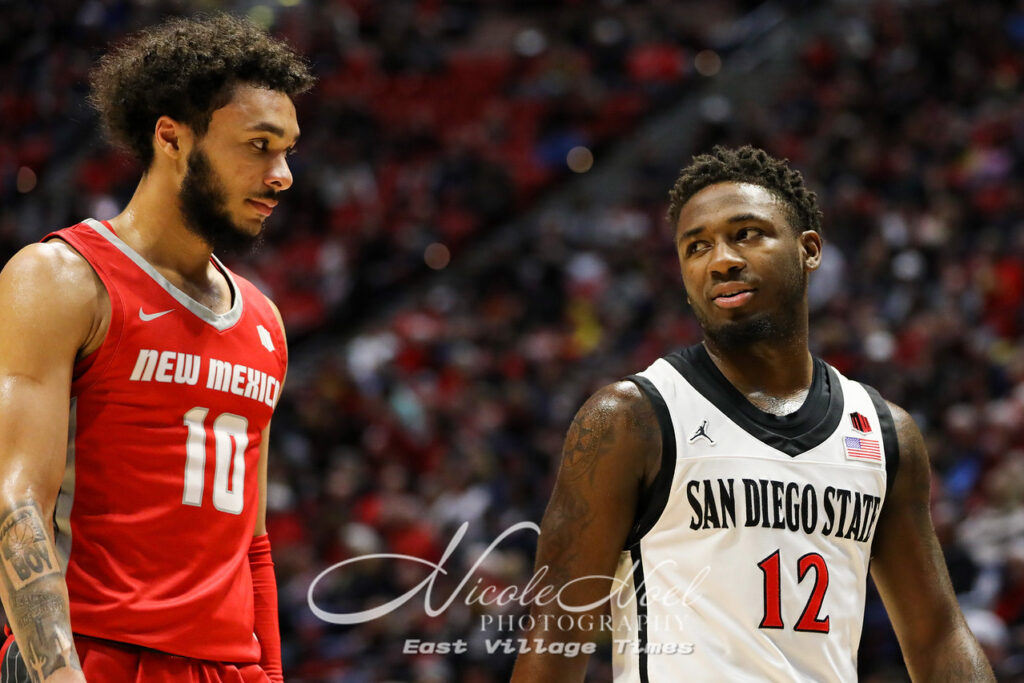
Jaelen House and Darrion Trammell interact during Saturday's contest. (Nicole Noel/EVT)
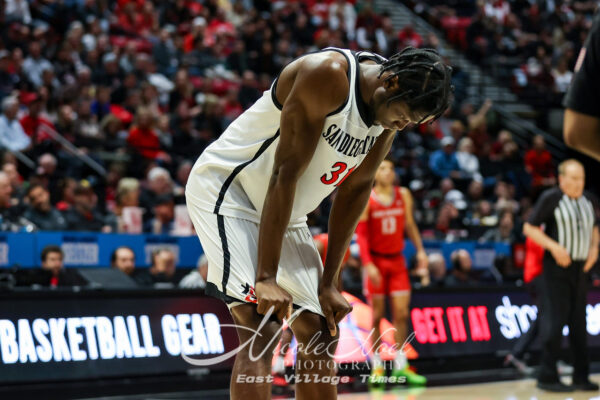
Nathan Mensah’s Foul Trouble
At the end of last season, Matt Bradley deemed Nathan Mensah, the team’s most valuable player. This year, it has become clear that Mensah is not only the most valuable Aztec, but he is also the best. He impacts both ends of the floor and makes everyone better around him. To call him the anchor of the team is a little imprecise. He is the star by which his teammates find their orbit.
Foul trouble has stopped Mensah this season more than any opponent. Whatever complaints anyone might have with the officials, it is up to the players to conform to the way the game is called. The crew at Viejas on Saturday does not typically officiate SDSU games, but they blew whistles against Mensah for the same infraction as those more familiar with the Ghanian star. In practice and in games, Mensah reaches from behind and knocks the ball away. It is a play head coach Brian Dutcher would like to see him stop.
“The point I’m trying to make to Nate is, when you slap it away from behind, we’re not getting steals off of it,” Dutcher said postgame following SDSU’s loss to New Mexico. “You’re knocking it out of bounds, and they’re getting the ball back. Maybe it frustrates the guy you’re going against, but if the refs aren’t allowing you to do that -whether it’s a foul or not- if they are calling a foul on it, you have to stop doing it.”
“This is dating back to last year. He gets a foul or two on that play every game. He’s too valuable defensively. It’s not like if he doesn’t do it, they are going to score on him. He’s capable of stopping them without doing that. Now, he’s got to concentrate and say, ‘maybe the percentage of me getting fouls on that play isn’t as great as playing straight up, and I can stop that guy anyway without doing that.’ We have to grow both he and I into what we’re accepting of him doing in there.”
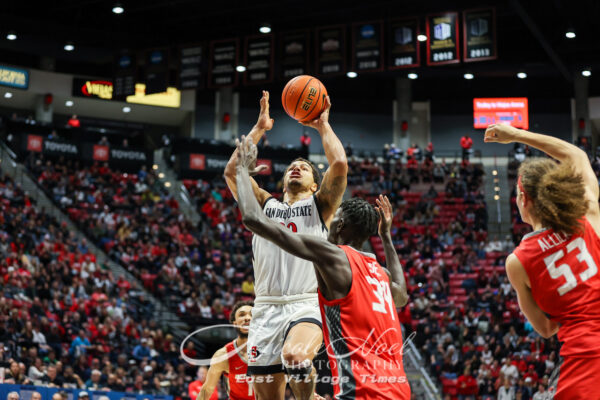
Turning the tables on the Aztecs
Teams in the Mountain West save wrinkles in their game plan for when they play the Aztecs. Usually, this involves showing a different look on the offensive end. New Mexico’s change-up occurred with their defense. They chose to match up 6’8 235 pound forward Josiah Allick on Matt Bradley. Normally, it is SDSU that puts its biggest players to defend on the perimeter.
“No, I didn’t expect him to guard me,” Bradley said postgame when asked if SDSU’s game plan had Allick guarding him. “I, kind of, let it get to me a little bit. I settled (for jump shots). I could have attacked him more. The one time I did, it almost was an ‘and-one,’ so I think I made that decision too late. I kept throwing up threes after threes, and my shots weren’t going down. I wish I would have kept driving, putting pressure on the defense. But he stepped up tonight, big time.”
It is difficult to say how much the tactic disrupted Bradley. Allick’s length did not seem to bother Bradley. SDSU’s guard hunts and makes tough shots. Where it was apparent Allick disrupted Bradley was with his size. Allick handled Bradley’s physicality better than most. Still, Bradley paced the Aztecs with 14 points and a game-high five assists by taking advantage of holes in the Lobos’ defense caused by Allick playing where he typically does not.
Moving forward, opposing coaches will decide how impactful Allick was at guarding Bradley and if they have the ability to duplicate it. Dutcher said postgame SDSU was comfortable with the matchup.
One other interesting aspect of the tactic is New Mexico only employed it when Keshad Johnson was in the game. When Mensah and Jaedon LeDee played together, it forced Allick inside.
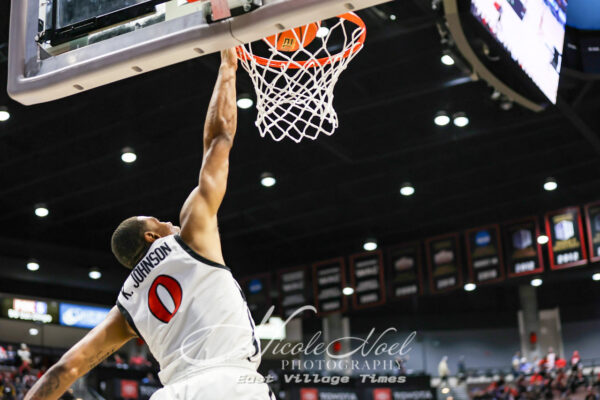
An eye on next season
College basketball’s transient nature means there is no guarantee they will take the court together, but the three freshmen on the roster are very athletic. Demarshay Johnson, Miles Byrd, and Elijah Saunders put on a show during warmups. Their promise is clear.
SDSU’s current team is very athletic, but on some nights, their less-than-elite lateral quickness and lack of leaping ability stand out. Against Arizona earlier in the season was an example and its contest against New Mexico was another. Even with Nathan Mensah’s foul trouble, the Aztecs’ size advantage should have been more pronounced. The Lobos were able to use their speed to counter SDSU’s girth. There is hope Saunders, Byrd, and Johnson could inject more quick twitch elements into the mix next year.
The Aztecs will have an entirely new identity next season with the departures of Mensah, Bradley, Aguek Arop, and Adam Seiko. With most of those subtractions in the frontcourt, Saunders and Johnson have the clearest path to playing time.
BJ Davis and Miles Heide are the only expected additions from the high school ranks. SDSU will likely be active in the transfer portal.
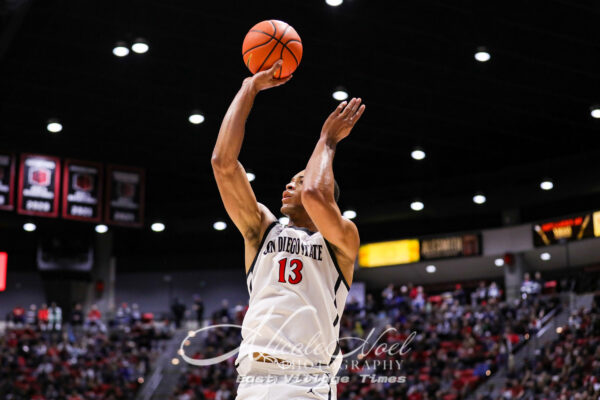
Jaedon LeDee’s evolving role
One of the enduring questions about this year is the role Jaedon LeDee should have. Most nights, he looks to be the best scoring option among the frontcourt Aztecs. With the scoring prowess SDSU possesses outside, LeDee appears to be a perfect complement as the third scorer to Matt Bradley and Darrion Trammell.
After scoring eight in only 18 minutes against Wyoming and nine in just 16 minutes against Nevada, it is natural to wonder what his impact would be with more opportunity. Saturday’s contest gave some insight into why Dutcher does not give more of Keshad Johnson, Arop, and Elijah Saunders’ minutes to LeDee.
What makes SDSU unique, what makes them special from other teams, is how they are able to play defense. Unlike most, they switch all ball screens for most of the game. Dutcher can employ the strategy because of Mensah’s unique skills. When SDSU’s center is out of the game, LeDee has the unenviable task of filling his role. Arop also gets that opportunity at times, but his size limitations make LeDee a better fit.
LeDee has done a good job on the ball, switching and covering post and perimeter players well. Where he still has considerable room for growth is off the ball. Unlike most bigs, Mensah is able to hedge, help, switch, and do what is required to play great team defense away from the point of attack. LeDee is not alone in having trouble duplicating that. It is one of the primary reasons more teams do not switch every screen. Players with great size get lost off the ball.
One sequence offers a telling example. Following Mensah’s technical, Dutcher put in a play where SDSU’s bigs guarded New Mexico’s wing players as the Lobos inbounded the ball under the Aztecs’ basket. The idea is when the Lobos’ bigs screen for their guards, SDSU could switch those, and there will not be any mismatches.
Whatever the virtue of calling a unique defense when your best defender just went out, the tactic failed miserably, and Jaelan House got a wide-open three. On the play, LeDee surfed indecisively instead of picking up the post player so Trammell could sprint to the opposite corner and no help would be given.
“Nate gets a reach in and a technical for two points,” Dutcher said postgame. “I tried to change the defense on a baseline out of bounds. It didn’t get done. They threw it inside on Darrion; we went and doubled and gave their best player a three. Five points in that one possession. We go from up one to down four.”
Mensah fouled out with 8:20 left. New Mexico had 48 points. They scored 28, 37% of their total, to close the game. Dutcher already trades offense for defense for his top two scorers; doing the same for the third would make SDSU average on the defensive end.
LeDee has already improved defensively this year and will continue to do so. That Dutcher, at a crucial moment, called that defensive play is a sign LeDee is trusted and close to providing what is needed. There is another level for the Aztecs to reach, but they will only get there if LeDee can master more of the defensive subtleties.
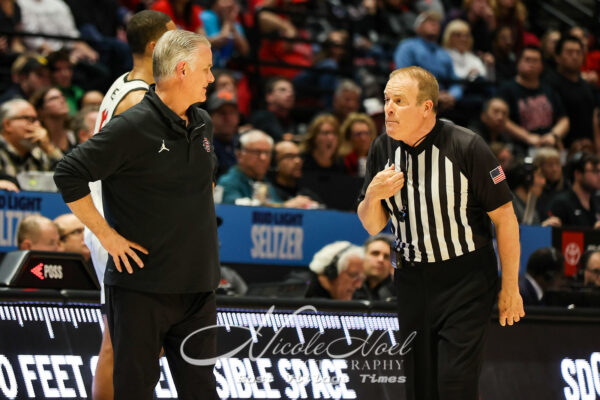
Quick Takes:
– The technical foul Gerry Pollard gave against Mensah was a judgment call. The one against House was to match the one against Mensah. The most disappointing for Aztecs’ fans was the one he did not award to head coach Richard Pitino. After Pitino called a timeout and started protesting a non-call, Pollard sprinted down the court to confront Pitino but did not call a technical. Pitino’s antics were far more animated than Mensah’s.
[wpedon id=”49075″ align=”right”]
– SDSU sells tickets to the student section when school is not in session. They should have included Saturday’s game in the promotion. The Show was noticeably absent just a few days before the start of the spring semester.
– Dutcher said before the team left for Wyoming that the goal of conference play is to win all the games at home while splitting on the road. SDSU just gave one away at Viejas, where are they going to get it back?
– Seiko played very well, and his role and minutes should increase. Like Mensah, he makes those around him better. He was a very efficient 4-6 from the field.
– Following wins, SDSU players head to the baseline and greet their fellow students. Near this same area, the New Mexico faithful welcomed their triumphant team
My earliest sport’s memory involve tailgating at the Murph, running down the circular exit ramps, and seeing the Padres, Chargers and Aztecs play. As a second generation Aztec, I am passionate about all things SDSU. Other interests include raising my four children, being a great husband and teaching high school.